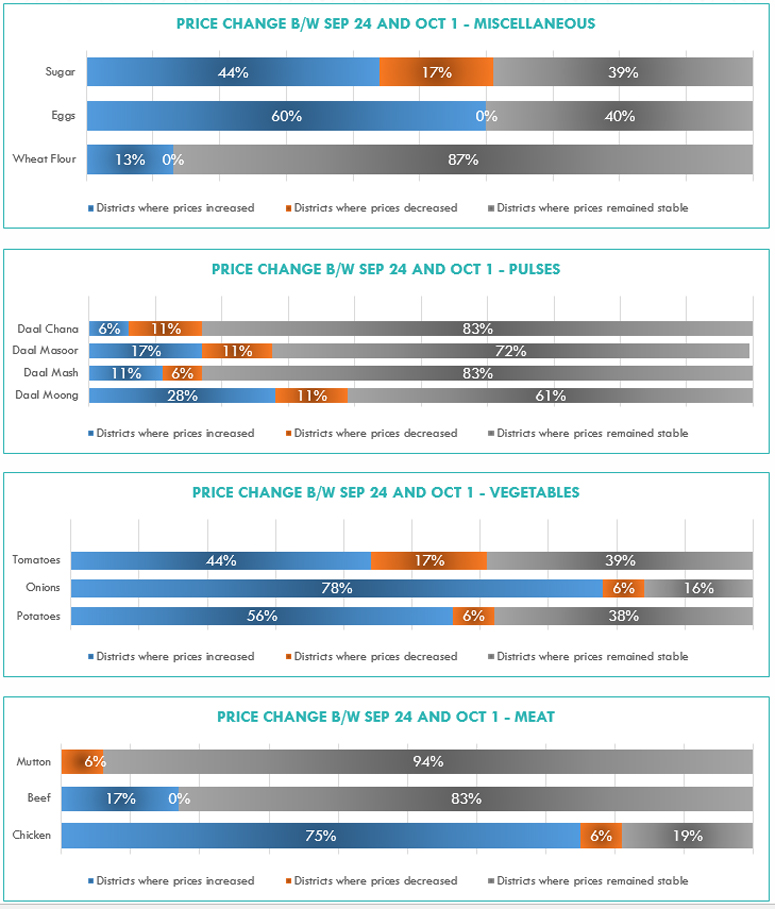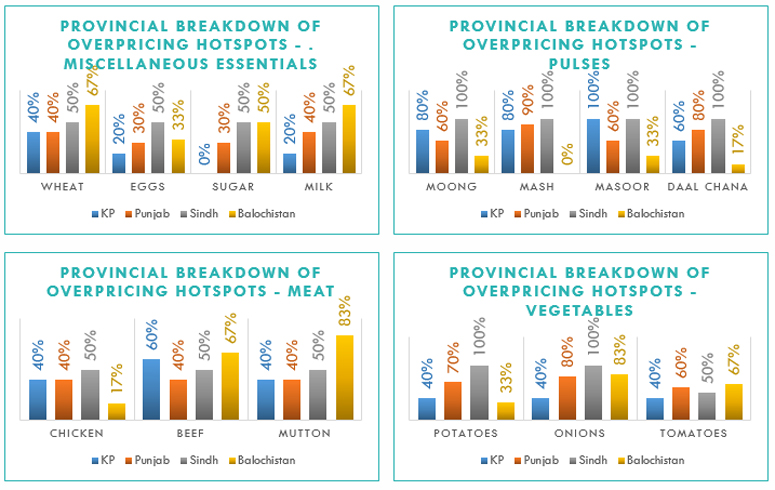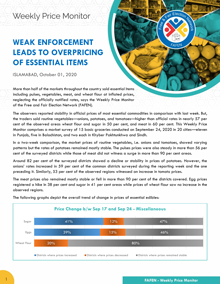ISLAMABAD, October 07, 2020: Traders paid no heed to the officially notified prices of essential commodities including vegetables, eggs, meat, and pulses as the monitoring at the district level remained weak, says the Weekly Price Monitor of the Free and Fair Election Network (FAFEN).
Merchants sold routine vegetables including onions, potatoes, and tomatoes at higher than official rates in nearly two-third of the observed areas. At the same time, wheat flour and sugar also had inflated rates in 38 per cent of surveyed regions.
This Weekly Price Monitor comprises a market survey of 15 basic groceries conducted on October 1, 2020, in 24 cities—twelve in Punjab, six in Balochistan, and three each in Khyber Pakhtunkhwa and Sindh.
In a two-week comparison, the market prices of routine vegetables, i.e. onions and tomatoes, were unstable as around 60 per cent of the commonly observed markets witnessed a surge in prices of these items. The pulses prices remained steady in more than 85 per cent of the covered districts while those of meat saw no increase in more than 92 per cent areas.
Around 78 per cent of the districts showed an increase in prices of onions. The rates of potatoes also rose in 56 per cent of the common districts surveyed during the reporting week and the one preceding it. Similarly, 44 per cent of the observed regions witnessed an increase in tomato prices.
The meat prices remained mostly stable or fell in more than 92 per cent of the districts covered. Egg prices registered a hike in 60 per cent and sugar in 44 per cent areas while prices of wheat flour increased in 13 per cent of the observed regions.
The following graphs depict the overall trend of change in prices of essential edibles:

The observers from several districts reported that essential grocery items’ official prices were not notified or readily available. The official rates of sugar and wheat flour were not accessible in 63 per cent and 42 per cent of the districts.
The same went for three pulses—mash, masoor, and chana—missing in nearly 17 per cent of the regions and moong pulse in 13 per cent.
Milk and yogurt prices were not publicly available in 29 per cent districts. Moreover, meat prices were missing in 13 per cent regions and poultry in 33 per cent. However, the vegetables’ official rates were generally available except for four per cent of the surveyed markets.
The interactive graph below shows the percentage of areas where official prices of essential commodities were missing:
The enforcement of the official market prices varied considerably across districts. The traders sold onions above the officially notified price in 71 per cent of the regions covered. The overpricing ranged between Rs2 (Lahore) and Rs40 (Washuk). Similarly, tomatoes and potatoes went above the official rates in 71 and 58 per cent areas. The highest difference in the official and market prices of potatoes was in Washuk, where they went Rs55 above the official rates. In contrast, tomatoes soared Rs70 above the official price in Jhal Magsi.
In the meat category, mutton and beef were overpriced in 63 per cent of districts. The markets in Karachi South sold mutton and beef higher than official prices of Rs810 and Rs285, respectively. Moreover, markets in nearly 25 per cent of districts did not follow the officially notified rates of chicken. Panjgur reported the highest difference of Rs22 in the market price and official chicken rate.

The official and market prices of various pulses also saw a significant difference in many regions. Mash and moong pulses were sold above the official prices in 67 per cent while chana and masoor pulses at higher rates in 63 and 57 per cent of the districts. In Karachi South, moong, mash, masoor, and chana pulses retailed at Rs150, Rs163, Rs144, and Rs118 above the officially notified rates.
A 20-kilogram wheat flour bag went Rs470 above the official rate in Mardan. Similarly, refined sugar was Rs31 higher in Karachi South. The market prices of per dozen eggs were also more than the officially notified rates in 33 per cent districts and the milk and yogurt rates in 46 per cent and 50 per cent of the observed regions.
About the Monitor:
TDEA-FAFEN generates the Weekly Price Monitor covering 15 essential kitchen items, including basic groceries such as wheat, pulses, oil, sugar, and perishable commodities like meat, and vegetables.
The observers sought the official prices for this survey from the district administration or the market committees, and the wholesale rates through market surveys. In the case of Punjab, the government price app Qeemat Punjab was also used to obtain the official rates.
To download the complete report, click here



